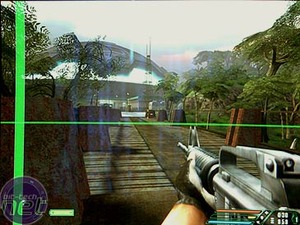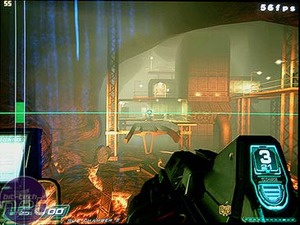
Compatibility
There has been a lot of discussion about whether two cards from different manufacturers will work together in SLI or not. The first thing to mention is that you cannot use any pair of GeForce 6 series video cards; they need to be based on the same GPU. Thus, you cannot run a GeForce 6800 Ultra in SLI with a GeForce 6600 GT. However, you could possibly use a GeForce 6800 GT in SLI with a GeForce 6800 Ultra, providing you flash the BIOS of one video card on to the other video card. The PCB layout is the same on both GeForce 6800 Ultra and GeForce 6800 GT, so theoretically, you could possibly get them to work together in SLI, providing the clock speeds, and BIOS are the same on both cards.
 Secondly, when buying a pair of video cards, make sure that they both have the SLI certification logo clearly displayed on the box cover, as displayed above on XFX's GeForce 6800 GT box. If you cannot see the logo, it is more than likely that the video card will not work in SLI. Thus, we can only recommend buying video cards with that logo clearly marked on the front. You can learn more about the SLI certification program and the manufacturers who are working together with NVIDIA to ensure that consumers get a quality product here.
Secondly, when buying a pair of video cards, make sure that they both have the SLI certification logo clearly displayed on the box cover, as displayed above on XFX's GeForce 6800 GT box. If you cannot see the logo, it is more than likely that the video card will not work in SLI. Thus, we can only recommend buying video cards with that logo clearly marked on the front. You can learn more about the SLI certification program and the manufacturers who are working together with NVIDIA to ensure that consumers get a quality product here.
We'll have a bit more information on compatibility and the two-phase upgrade path to SLI a little later this week. We're currently waiting for board partners to get back to us with their plans on how to handle a two-phase upgrade to SLI.
Rendering Modes
Back when SLI was first announced, NVIDIA talked a lot about Split Frame Rendering, which meant that the top portion of the scene would be rendered by the primary video card, while the bottom portion of the scene would be rendered by the secondary video card. However, when NVIDIA actually released SLI to reviewers back in November, they had introduced a second rendering mode, known as Alternate Frame Rendering. We don't really need to explain what this means, as it does what it says on the tin.
Split Frame Rendering is a solution that we have seen before on 3Dfx's SLI solutions. However, unlike 3Dfx's implementation, which split the frame multiple times, NVIDIA have opted to split the frame a single time and render the top portion on the primary card and bottom portion on the slave. When both of the cards have finished rendering their portion of the frame, the slave passes its rendering data across the SLI Bridge that joins the two cards together. The primary card then stitches the two portions of the frame together and sends them to RAMDAC ready for displaying on the users screen.

 One issue for NVIDIA is for them to make sure that the load-balancing algorithm works correctly across the board. Let us take Far Cry for example - a game that uses the Split Frame Rendering technique. The bottom portion of the frame is populated by the complex geometry and sprites that make up the environment, while the top portion contains some geometry and the large sky box. Early implementations of load balancing algorithms were not great, but NVIDIA has since worked to solve the teething problems, as we will see a little later on.
One issue for NVIDIA is for them to make sure that the load-balancing algorithm works correctly across the board. Let us take Far Cry for example - a game that uses the Split Frame Rendering technique. The bottom portion of the frame is populated by the complex geometry and sprites that make up the environment, while the top portion contains some geometry and the large sky box. Early implementations of load balancing algorithms were not great, but NVIDIA has since worked to solve the teething problems, as we will see a little later on.

 Alternate Frame Rendering works slightly differently. The CPU and GPU work on each frame at the same time before moving on to the next frame to be processed. The frames alternate between video cards, improving performance in non-CPU limited situations. At lower resolutions, you are less likely to see an improvement in performance with Alternate Frame Rendering. The primary video card is still responsible for displaying the final scene to the monitor - once the slave has finished rendering its frame, it will send the contents of its memory across the SLI connector ready for the primary video card to send to RAMDAC, ready for outputting to the monitor.
Alternate Frame Rendering works slightly differently. The CPU and GPU work on each frame at the same time before moving on to the next frame to be processed. The frames alternate between video cards, improving performance in non-CPU limited situations. At lower resolutions, you are less likely to see an improvement in performance with Alternate Frame Rendering. The primary video card is still responsible for displaying the final scene to the monitor - once the slave has finished rendering its frame, it will send the contents of its memory across the SLI connector ready for the primary video card to send to RAMDAC, ready for outputting to the monitor.
If you want to see which rendering mode a particular title uses, you can enable an option in the driver that shows the load balancing between the two video cards. In Split Frame Rendering mode, the horizontal line moves up and down the screen to show how much of the image is being rendered by each video card. With Alternate Frame Rendering, the horizontal line stays in the centre of the screen, while the vertical bar at the side moves up and down. It is not known how the vertical bar represents load though.
Each game has its own SLI profile, and they're all listed in an important file called nvapps.xml, which is located in your System32 folder in the Windows directory. For each game that we have tested, we have listed the contents of nvapps.xml to hopefully give you some kind of idea of how SLI is configured by the driver to attain the best possible performance in each particular title. NVIDIA have a dedicated SLI driver team who work on improving SLI performance on top of the regular driver team that release the official drivers on a reasonably regular basis.
There has been a lot of discussion about whether two cards from different manufacturers will work together in SLI or not. The first thing to mention is that you cannot use any pair of GeForce 6 series video cards; they need to be based on the same GPU. Thus, you cannot run a GeForce 6800 Ultra in SLI with a GeForce 6600 GT. However, you could possibly use a GeForce 6800 GT in SLI with a GeForce 6800 Ultra, providing you flash the BIOS of one video card on to the other video card. The PCB layout is the same on both GeForce 6800 Ultra and GeForce 6800 GT, so theoretically, you could possibly get them to work together in SLI, providing the clock speeds, and BIOS are the same on both cards.

We'll have a bit more information on compatibility and the two-phase upgrade path to SLI a little later this week. We're currently waiting for board partners to get back to us with their plans on how to handle a two-phase upgrade to SLI.
Rendering Modes
Back when SLI was first announced, NVIDIA talked a lot about Split Frame Rendering, which meant that the top portion of the scene would be rendered by the primary video card, while the bottom portion of the scene would be rendered by the secondary video card. However, when NVIDIA actually released SLI to reviewers back in November, they had introduced a second rendering mode, known as Alternate Frame Rendering. We don't really need to explain what this means, as it does what it says on the tin.
Split Frame Rendering is a solution that we have seen before on 3Dfx's SLI solutions. However, unlike 3Dfx's implementation, which split the frame multiple times, NVIDIA have opted to split the frame a single time and render the top portion on the primary card and bottom portion on the slave. When both of the cards have finished rendering their portion of the frame, the slave passes its rendering data across the SLI Bridge that joins the two cards together. The primary card then stitches the two portions of the frame together and sends them to RAMDAC ready for displaying on the users screen.




If you want to see which rendering mode a particular title uses, you can enable an option in the driver that shows the load balancing between the two video cards. In Split Frame Rendering mode, the horizontal line moves up and down the screen to show how much of the image is being rendered by each video card. With Alternate Frame Rendering, the horizontal line stays in the centre of the screen, while the vertical bar at the side moves up and down. It is not known how the vertical bar represents load though.
Each game has its own SLI profile, and they're all listed in an important file called nvapps.xml, which is located in your System32 folder in the Windows directory. For each game that we have tested, we have listed the contents of nvapps.xml to hopefully give you some kind of idea of how SLI is configured by the driver to attain the best possible performance in each particular title. NVIDIA have a dedicated SLI driver team who work on improving SLI performance on top of the regular driver team that release the official drivers on a reasonably regular basis.

MSI MPG Velox 100R Chassis Review
October 14 2021 | 15:04








Want to comment? Please log in.